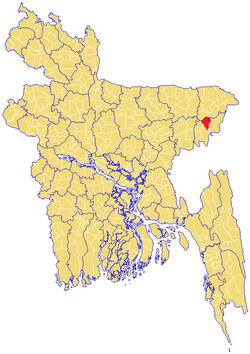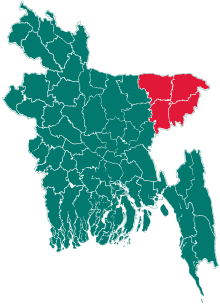Rajnagar Upazila
Rajnagar (Bengali: রাজনগর, Sylheti: ꠞꠣꠏꠘꠉꠞ) is an Upazila of the Moulvibazar District[1] in the Division of Sylhet, Bangladesh. The district has roughly 29,300 houses and an area of approximately 340 km². There are three well-known rivers which flow across the Upazila border side of Rajnagar: the Kushiara in the North, the Manu across the southern three unions (Kamarchak, Tengrabazar, and Mansurnager), and the Dholai across Kamarchak and the southern border.
Rajnagar রাজনগর ꠞꠣꠏꠘꠉꠞ | |
|---|---|
| Nickname(s): City of the King | |
 | |
| Division | Sylhet Division |
| District | Moulvibazar District |
| Government | |
| • MP (Maulvibazar-3) | Nesar Ahmed (Bangladesh Awami League) |
| • Upazila Chairman | Shahjahan Khan (Awami League) |
| Area | |
| • Total | 338.15 km2 (130.56 sq mi) |
| Population | |
| • Total | 174,280 |
| • Density | 515/km2 (1,330/sq mi) |
| Demonym(s) | Rajnagari, Rajnogori, Raznogori |
| Time zone | UTC+6 (BST) |
| Postal code | 3240 |
| Website | rajnagar |
- See Rajnagar for disambiguation
Etymology
The name of the city, Rajnagar is derived from two words, Raj and nagar, meaning "City of the King". It possibly refers to the kings of the ancient Ita kingdom wherein Rajnagar was the capital.
History
It is suggested that the area was inhabited by Buddhists and Hindus as evidence from inscriptions suggests there was an ancient university in Panchgaon, Rajnagar.[2] The terrain was headquarters of the ancient Ita Kingdom founded by Raja Bhanu Narayan and its capital was in the villages of Bhumiura and Eolatoli.. Copper plates have been found from 930 AD in Paschimbagh, Tengubazar Mandir, Rajnagar. The district was also part of the ancient Kamarupa kingdom. In the mid-14th century, Shah Ruknuddin settled and propagated Islam in Kadamhata, Ita Pargana. Ruknuddin's mazar remains in Kadamhata Bazar.
Rajnagar contains many tea gardens and historical places. During the Bangladesh Liberation War, the Panchgaon Factory in Rajnagar Upazila produced cannons under the command of M. A. G. Osmani. A famous historical cannon, nicknamed Jahankosa, built by Janardan Karmakar remains in display in Dhaka.[2] The first Upazila Chairman Freedom Fighter Rana Choudhury is the founder of Rajnagar Degree College (Principal Abdul Ahad Choudhury founded the college in 1982); Major General Abdu Rab is the co-founder of that college. The present Upazila Chairman is Freedom Fighter Md. Askir Khan of the Ruling Party Awamileague. For the last two terms Md. Misbahuduzza (Velai) of Awamileague has been the Upazila Chairman of Rajnagar. Munshibazar is one of the most important commercial unions in this Upazila due to the large number of goods and services. The tea gardens produce plenty of different types of tea and fruit as well. It has big Hawrs and hills that makes it unique one in the upazilla. A list of important figures in Munshibazar are given below.
- Eng. Syed Golam Sarwar, Ex-Superintendent Engineer, DPHE, BANGLADESH
- Mr. Mohtossir Ali, Educationalist
- Mr.Engineer Farashat Ali, Chairman, NRB Commercial Bank Limited, Bangladesh
- Dr. Syed Sharmin Sarwar, M. A. G. Osmani Medical college, Sylhet, Bangladesh.
- Mr. Syed Golam Shahajarul Alam, Joint Director, Bangladesh Bank.
- Mr. Khan Jamal Nurul Islam. writer & Journalist (Editor-of Shahajalal Darpan (fortnight Bengali).
- Mr. K M Abu Taher Choudhury . Prominent Journalist (President of Bangladesh Journalist Association of UK.)
KAMARCHAK UNION : The Kamarchak Union is the most famous of the eight unions, as many well-known people were born and still live in the region. Most of the people are peaceful, progressive and creative . The union consists of 44 villages and does substantial business through foreign exchange earned by man-power exported in different countries in the World . In 1971, during the freedom fighting, Kamarchak was one of the most advantageous place and safe heaven for freedom fighters. Fighters under Kazi Jafor Ahmed, ex-Prime Minister of the Jatiya Party government,Organized and fought from this union. Kamarchak is almost surrounded by two rivers - the Manu to the north and the Dholai across (which is crisscrossed by the Udna and the Palki, two smaller rivers). Very often, this union becomes affected by floods but produces plenty of paddy, sugarcane, and vegetables. River erosion, flooding, a poor communications infrastructure, and a low literacy rate are the four main problems. The "Vishnu Pod" Dham (named after the Foot Sign of God Vishnu), one of the sacred places of the Hindus, is situated half a kilometer away,to the east of Tarapasha Bazar. Tarapasha High School, (now a high school and college) founded in 1932 on the donated estate of the Nag family, is one of the oldest educational institutions in Rajnagar. The founding headmaster of this school was late Md. Rezawar Khan, a very respected educator. There is a Branch of Bangladesh Sonali Bank since three decades.
Demographics
As of the 2011 Bangladesh Census, Rajnagar's population was 232,666, with 113,149 males and 119,517 females. The religious make-up is 180,566 Muslims, 51,867 Hindus, 4 Buddhists, 133 Christians, and 92 people of other religions. This Upazila's over-18 population is about 100,000. Rajnagar has an average literacy rate of 48.6%, above the national average of 42.4%.[3]
Climate
| Climate data for Rajnagar | |||||||||||||
|---|---|---|---|---|---|---|---|---|---|---|---|---|---|
| Month | Jan | Feb | Mar | Apr | May | Jun | Jul | Aug | Sep | Oct | Nov | Dec | Year |
| Average high °C (°F) | 25.5 (77.9) |
27.7 (81.9) |
31.5 (88.7) |
32.3 (90.1) |
31.9 (89.4) |
31.4 (88.5) |
31.4 (88.5) |
31.6 (88.9) |
31.7 (89.1) |
30.9 (87.6) |
29.0 (84.2) |
26.4 (79.5) |
30.1 (86.2) |
| Average low °C (°F) | 10.2 (50.4) |
12.5 (54.5) |
17.3 (63.1) |
21.0 (69.8) |
22.9 (73.2) |
24.4 (75.9) |
24.9 (76.8) |
24.9 (76.8) |
24.5 (76.1) |
22.0 (71.6) |
16.5 (61.7) |
11.9 (53.4) |
19.4 (66.9) |
| Average precipitation mm (inches) | 15 (0.6) |
30 (1.2) |
110 (4.3) |
263 (10.4) |
443 (17.4) |
596 (23.5) |
497 (19.6) |
429 (16.9) |
331 (13.0) |
213 (8.4) |
36 (1.4) |
6 (0.2) |
2,969 (116.9) |
| Source: Climate-data.org | |||||||||||||
Administration
Rajnagar has 149 mouzas and 255 villages categorised into 8 Union Parishads:
- Fatehpur
- Uttorbhag
- Munshibazar
- Panch goan
- Rajnagar
- Tengrabazar
- Kamarchak
- Mansurnagar Union
See also
- Upazilas of Bangladesh
- Districts of Bangladesh
- Divisions of Bangladesh
References
- Shah Md. Muizur Rahman (2012), "Rajnagar Upazila", in Sirajul Islam and Ahmed A. Jamal (ed.), Banglapedia: National Encyclopedia of Bangladesh (Second ed.), Asiatic Society of BangladeshCS1 maint: uses authors parameter (link)
- "Zila". Moulvibazar.com. January 2016. Retrieved 4 September 2018.
- "Population Census Wing, BBS". Archived from the original on 2005-03-27. Retrieved November 10, 2006.
